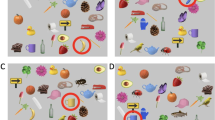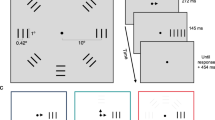Abstract
We describe in this paper a new CMOS multimode image pixel sensor (MIPS) dedicated to an implantable visual cortical stimulator. Each 16 μm × 16 μm pixel area contains a photodiode, with a fill factor of 22%, a comparator used to convert the pixel level from analog to digital (A/D) values and an 8-bit DRAM, resulting in a total of 44 transistors per pixel. The A/D conversions use one common digital to analog converter to deliver the voltage reference needed to determine the pixel voltage. Three selectable operation modes are combined in the proposed MIPS: A high dynamic range logarithmic mode, a linear integration mode, and a novel differential mode between two consecutive images. This last mode that allows 3D information is required for a visual cortical stimulator. A test chip has been fabricated in CMOS 0.18 μm technology and tested to validate the full operation of the different proposed modes.
Similar content being viewed by others
References
J. Coulombe, M. Sawan, and C. Wang, “Variable resolution CMOS current mode active pixel sensor.” IEEE Int. Symposium on Circuit and Systems, Geneva, Switzerland, May 2000, vol. 2, pp. 293–296.
S. Decker, R.D. McGrath, K. Brehmer, and C.G. Sodini, “A 256×256 CMOS imaging array with wide dynamic range pixels and column-parallel digital output.” J. Solide State Circuits, vol. 33, pp. 2081–2091, Dec. 1998.
J.-L. Trepanier, M. Sawan, Y. Audet, and J. Coulombe, “A wide dynamic range CMOS digital pixel sensor.” IEEE Int. Midwest Symposium on Circuit and Systems, pp. 437–440, 2002, Tulsa, USA.
A. Trepanier, J.-L. Trepanier, M. Sawan, and Y. Audet, “A multiple operation mode CMOS digital pixel sensor dedicated to a visual cortical implant.” IEEE Int. Midwest Symposium on Circuits and Systems, Hiroshima, Japan, 2004, vol. 1, pp. 369–372.
S. Pigeon, M. Meunier, and M. Sawan, “Design and fabrication of a microelectrode array dedicated for Cortical Electrical Stimulation.” IEEE-CCECE, pp. 813–816, 2003.
P. Troyk, M. Bak, J. Berg, D. Bradley, S. Cogan, R. Erickson, C. Kufta, D. McCreery, E. Schmidt, and V. Towle, “A model for intracortical visual prosthesis research.”, Artificial Organs, vol. 27, no. 11, pp. 1005–1015, 2003.
J. Salvi, J. Pagés, and J. Batlle, “Pattern codification strategies in structured light systems.” Pattern Recognition, vol. 37, no. 4, pp. 827–849, 2004.
L.G. McIlrath, “A low-power low-noise ultrawide-dynamic-range CMOS imager with pixel-parallel A/D Conversion.” IEEE J. of Solide State Circuits, vol. 36, pp. 846–853, 2001.
S. Kleinfelder, S. Lim, X. Liu, and A. El Gamal, “A 10000 frames/s CMOS digital pixel sensor.” IEEE Journal of Solid State Circuits, vol. 36, pp. 2049–2059, 2001.
N. Tu, R. Hornseym, and S.G. Ingram, “CMOS active pixel image sensor with combined linear and logarithmic mode operation.” IEEE Canadian Conference on Electrical and Computer Engineering, Waterloo, vol. 2, pp. 754–757, 1998.
A. Yang, A. El Gamal, B. Fowler, and Hui Tian, “A 640×512 CMOS image sensor with ultrawide dynamic range floating-point pixel-level ADC.” J. Solide State Circuits, vol. 34, pp. 1821–1834, 1999.
J. Sturge, V. Walworth, and A. Shepp, “Introduction to images and imaging.” In Imaging Processes and Materials, Van Nostrand Reinhold (Eds.), New York, 1989.
Author information
Authors and Affiliations
Corresponding author
Additional information
Mohamad Sawan received the B.Sc. degree in electrical engineering from Université Laval, Canada in 1984, the M.Sc. and Ph.D. degrees, both in electrical engineering, from Université de Sherbrooke, Canada, in 1986 and 1990 respectively, and postdoctorate training from McGill University, Canada in 1991. He joined Ecole Polytechnique de Montréal in 1991 where he is currently a Professor in Microelectronics. His scientific interests are the design and test of mixed-signal (analog, digital and RF) circuits and systems, the digital and analog signal processing, the modeling, design, integration, assembly and validation of advanced wirelessly powered and controlled monitoring and measurement techniques. These topics are oriented toward the biomedical implantable devices and telecommunications applications. Dr. Sawan is a holder of a Canadian Research Chair in Smart Medical Devices.
He is leading the Microelectronics Strategic Alliance of Quebec (Regroupement stratégique en microélectronique du Québec – ReSMiQ). He is founder of the Eastern Canadian IEEE-Solid State Circuits Society Chapter, the International IEEE-NEWCAS conference, and Polystim neurotechnologies laboratory at the Ecole Polytechnique de Montreal. He is cofounder of the International Functional Electrical Stimulation Society (IFESS), and the IEEE International Conference on Electronics, Circuits and Systems (ICECS). Dr. Sawan is involved in the committees of many national and international conferences and other scientific events.
He published more than 350 papers in peer reviewed journals and conference proceedings and is awarded 6 patents. He is editor of the Springer Mixed-signal Letters, Distinguished Lecturer for the IEEE CAS Society, President of the biomedical circuits and systems (BioCAS) technical committee of the IEEE CAS Society, and he is representative of IEEE-CAS in the International Biotechnology council. He received the Barbara Turnbull 2003 award for spinal cord research, the Medal of Merit from Lebanon, and the Bombardier Medal from the French Association for the advancement of sciences. Dr. Sawan is Fellow of the Canadian Academy of Engineering, and Fellow of the IEEE.
Annie Trépanier received her Bachelor of Engineering Degree in Electrical Engineering in 2002 and her Master of Applied Sciences Degree in Microelectronics in 2005 from the Ecole Polytechnique de Montreal as a member of the Cortivision team in the Polystim Neurotechnologies Laboratory. She held a summer job at Nortel Networks and trained at Mindready. She is currently employed at Matrox, Montreal.
Jean-Luc Trépanier received his Bachelor of Engineering Degree in Electrical Engineering in 2000 and his Master of Applied Sciences Degree in Microelectronics in 2003 from the Ecole Polytechnique de Montreal where he was a member of the Cortivision team in the Polystim Neurotechnologies Laboratory. He started his first company, Olyxia inc., where he developed the soon to be released Cute Spider VoIP Network. He is also the founder and CEO of Nexyrius inc. which develops a new generation of embedded systems.
Yves Audet received his M.Sc. degree from a joint program between the University of Sherbrooke, QC, Canada and Université Joseph Fourier in Grenoble, France. He completed his Ph.D. at Simon Fraser University, BC, Canada. He has been working for three years in Research and Development with Mitel Corporation before being hired as assistant professor at École Polytechnique of Montreal, QC, Canada, in 2001. His research interests are CMOS sensor arrays and mixed signal circuits.
Roula Ghannoum received her Bachelor of Engineering Degree in Computer and Communications Engineering from the Lebanese American University, Byblos—Lebanon, in July 2005. She is currently pursuing her Master of Applied Sciences in Microelectronics at the Ecole Polytechnique de Montreal as a member of the Cortivision team in the Polystim Neurotechnologies Laboratory working on image sensors as part of a global project that aims at restoring sight to the visually incapacitated.
Rights and permissions
About this article
Cite this article
Sawan, M., Trépanier, A., Trépanier, JL. et al. A new CMOS multimode digital pixel sensor dedicated to an implantable visual cortical stimulator. Analog Integr Circ Sig Process 49, 187–197 (2006). https://doi.org/10.1007/s10470-006-9184-4
Received:
Revised:
Accepted:
Published:
Issue Date:
DOI: https://doi.org/10.1007/s10470-006-9184-4




